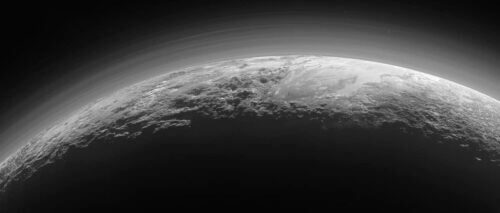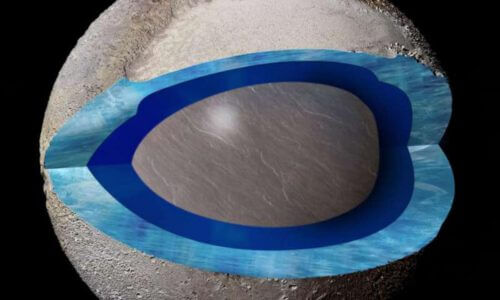Scientists around the world continue to analyze the data transmitted by the New Horizons spacecraft when it passed by Pluto and its moon Charon in 2015
Winds on Pluto

One of the most prominent formations on the surface of Pluto is the heart formation Tombaugh Regio named after the astronomer who discovered this planet. It is actually a huge glacier made entirely of nitrogen ice. It turned out that this glacier affects the circulations of the atmosphere. From the measurements of the New Horizons spacecraft it became clear that during the day, a thin layer of ice in this area heats up and evaporates. At night, these vapors condense and form nitrogen ice again. This is actually a cyclical operation. Each such cycle resembles a heartbeat that circulates nitrogen winds around Pluto. This cyclical movement pushes the atmosphere to perform an opposite movement in the opposite direction to Pluto's movement around itself. When the air hits the ground it transfers heat, ice grains and haze particles creating broad wind blows across northern and northwestern regions.
Most of Pluto's nitrogen ice is concentrated in the heart shape. The left lobe of the lobe is more than 1000 km long and is located in a 3 km deep basin called Sputnik Planitia. In the right lobe of the formation are the plateaus of the nitrogen glaciers.
using a computerized model to test the circulation of the air and its effect on the surface. It turned out that winds located 4 km above the ground blow in a west direction (opposite to the movement of Pluto around itself). When the nitrogen in the heart configuration evaporates in its northern part and turns into ice in the south. Its movement causes winds to blow in a westerly direction. This phenomenon has not been observed anywhere else in the solar system except perhaps on Neptune's moon Triton. In this model there is also a strong current of air near the ground along the western border of Sputnik Planitia. The air flow is similar to air movement patterns on Earth as in - Kuroshio along the eastern side of Asia. The condensation of nitrogen in the atmosphere drives this wind pattern. The large rocks in this area trap the cold air inside the basin. It begins to move in circulation and it becomes stronger stronger as it passes through the western region. The Sputnik Planitia area is probably as important as the ocean's influence on Earth's climate (1).
Underground ocean

After the photographs of the New Horizons arrived on Earth, they were compared with different models that tried to give different predictions regarding thermal developments in the interior of Pluto. Water as is known occupies a larger volume when it freezes and turns into ice and it occupies a smaller volume when it thaws and turns into a liquid. In terms of Pluto's development, each of these situations has different meanings in terms of tectonics, the characteristics of Pluto's surface and interior.
If Pluto started out as a cold planet and the ice inside it melted, the planet would have contracted and you would have seen compression features on the surface. If it had started as a hot body it would have expanded, when the water ocean froze one would notice expansion features on the surface. What you see in the photographs is a lot of evidence of expansions on the surface, but no evidence of compression on the surface. The evidence therefore supports the hypothesis that Pluto began with a liquid ocean.
The tectonic and thermal developments regarding Pluto's inception as a planet are a bit more complicated. This is because after as a planet it gradually melted, the underground ocean underwent further freezing. Therefore the contraction will start earlier and will be followed by expansion. With a new hot start the expansion has occurred throughout Pluto's history.
Calculations showed that if all the gravitational energy were stored as heat it would inevitably create a primordial liquid ocean (2).
Another spacecraft to Pluto?
The findings from the New Horizons spacecraft and the surprising conclusions have whetted the appetite of the researchers and they are starting to talk about planning another spacecraft to be launched to Pluto. This time it is not a transit flight, but a spacecraft that will enter orbit around it and perform a complete review of it. The duration of the assignment will be two national years. At the end of the mission, the spacecraft will be directed to another tiny body in the Koffier belt and another planet located in this space of the solar system. The meaning is that the spacecraft will use the gravitational force of its lunar coffin and from there to the other planet (3).
It would even be worthwhile to equip the spacecraft with an all-terrain vehicle that would land on Pluto. As for Charon, the desired trajectory for testing the two bodies is the use of a looping flight path where the spacecraft enters orbit around Pluto and at the point chosen for this purpose moves towards Charon, makes a half turn and returns to circle Pluto, circles it and returns to Charon again. This is a flight technique that the Russians used for the first time in Luna 3 that was launched to the moon.
Sources
1. 'Pluto's icy heart makes winds blow" 5.2.2020
2. 'Evidence supports a 'hot start' scenario and early ocean formation on Pluto"23.6.2020
3. Mike Wall - "NASA eyes possible return to Pluto, with a longer stay" 1.11.2019
More of the topic in Hayadan:

3 תגובות
Very very intriguing what goes on there (even a little scary I would say). Am I correct in seeing the shape of the underground ocean - in the shape of a heart.
Durish
From your response I understand that Hebrew is not common in your mouth at all. I recommended that you return urgently to the first grade.
Really interesting, but why with so many spelling and grammar errors?